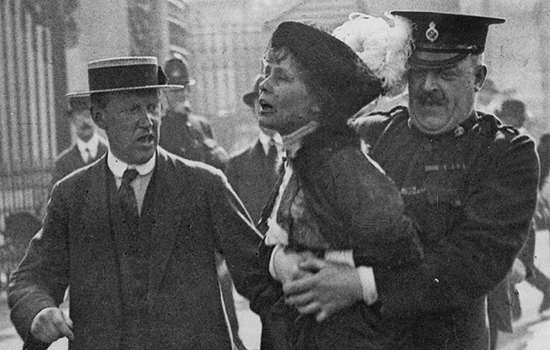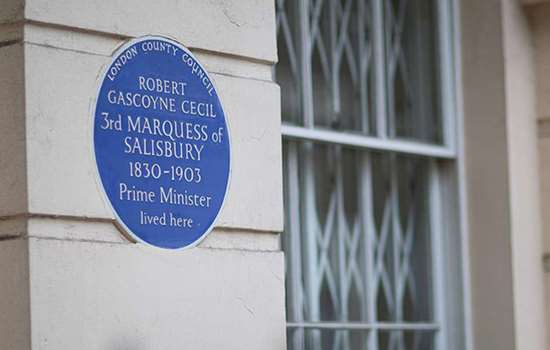ROHMER, Sax (1883–1959) a.k.a. Arthur Henry Ward
Plaque erected in 1985 by Greater London Council at 51 Herne Hill, Herne Hill, London, SE24 9NE, London Borough of Southwark
All images © English Heritage
Profession
Writer
Category
Literature
Inscription
SAX ROHMER Arthur Henry Ward 1883–1959 Creator of Dr. Fu Manchu lived here
Material
Ceramic
Sax Rohmer was the pen name of Arthur Henry Ward, a popular writer who is best known for his series of novels featuring the evil genius – and racial stereotype – Dr Fu Manchu. A blue plaque at 51 Herne Hill marks the place where Rohmer lived between 1910 and 1919.
Early life and career
Henry Arthur Ward was born in Birmingham to parents of Irish origin and moved with them to south London in the 1880s.
Beginning as a clerk and then a newspaper reporter, he also worked as a ghostwriter for the music hall comedians George Robey and ‘Little Tich’. His interest in Egyptology and the occult inspired him to produce one of his first short stories, The Mysterious Mummy (1903), written under the name of Arthur Sarsfield Ward.
Writing as Sax Rohmer, his first Fu Manchu story was serialised in 1912. The Mystery of Fu Manchu (or Sinister Fu Manchu) of 1913 introduced its villain as ‘the yellow peril incarnate in one man’, intent on world domination via white slavery and drug trafficking from his den in dockside Limehouse – then the heart of London’s small and often transient Chinese community.
The first three Fu Manchu novels, published between 1913 and 1917, were written at 51 Herne Hill. Rohmer moved there in 1910, following his marriage to Rose Elizabeth Knox, a variety-act juggler and the sister of a member of British entertainers The Crazy Gang. The couple were the first occupants of the house, which they shared with Rohmer’s father, Bill. However, as they were childless, they found the place ‘a trifle larger than they really needed’, and in 1919 left for Bruton Street, Mayfair.
The Fu Manchu Series
The Fu Manchu books appeared in the wake of the Boxer Rebellion and anti-Manchu revolution in China. The overtly racist characters and plots deliberately played upon fears about British imperial decline, Asian immigration to Britain, East End opium dens, and marriage between Chinese sailors and English women in Limehouse. Such stories had gripped the press from the late 19th century, and Rohmer’s fiction was very much in the same sensationalist tradition.
As he told his biographers, ‘conditions for launching a Chinese villain on the market were ideal’.
Rohmer was not the first to depict the East End opium den as an exotic haunt of depraved or cunning ‘Orientals’. From the 1860s Charles Dickens, Oscar Wilde and Arthur Conan Doyle had, among others, focused on this mysterious (and largely fictional) world and its potential for contaminating English as well as Asian people.
At the formation of the People’s Republic of China in 1949, Rohmer responded with Shadow of Fu Manchu, in which the protagonist tries to save the world from the ‘leprosy of communism’.
Later Work and Legacy
Rohmer returned to Fu Manchu in 1931 and, despite killing him off several times, he would publish 13 Fu Manchu novels out of a total of more than 70 fictional works.
The books reached an even greater audience through film adaptations, and in his day Fu Manchu became as well-known as Dracula and Sherlock Holmes. Consequently, Rohmer is said to have been one of the highest-paid novelists of the interwar years.
In part because of their lurid covers, the books’ combination of pantomime villainy and gothic horror appears to have secured them a place among cult pulp fiction.
Further Reading
- Robert Bickers, ‘Ward, Arthur Henry [Arthur Sarsfield Ward; pseud. Sax Rohmer]’, Oxford Dictionary of National Biography (access with a UK public library card)
- Anne Witchard, Chinese Limehouse and ‘Mr Ma and Son’ (accessed 14 Oct 2020)
- Cay Van Ash and Elizabeth Sax Rohmer, Master of Villainy: A Biography of Sax Rohmer (London, 1972)
- Christopher Frayling, The Yellow Peril: Dr Fu Manchu & The Rise of Chinaphobia (London, 2014)
- John Seed, ‘Limehouse Blues: Looking for “Chinatown” in the London Docks, 1900–40’, History Workshop Journal (autumn 2006), 58–85
- Ruth Mayer, Serial Fu Manchu: The Chinese Supervillain and the Spread of Yellow Peril Ideology (Philadelphia, 2013) (accessed 24 Dec 2024)


